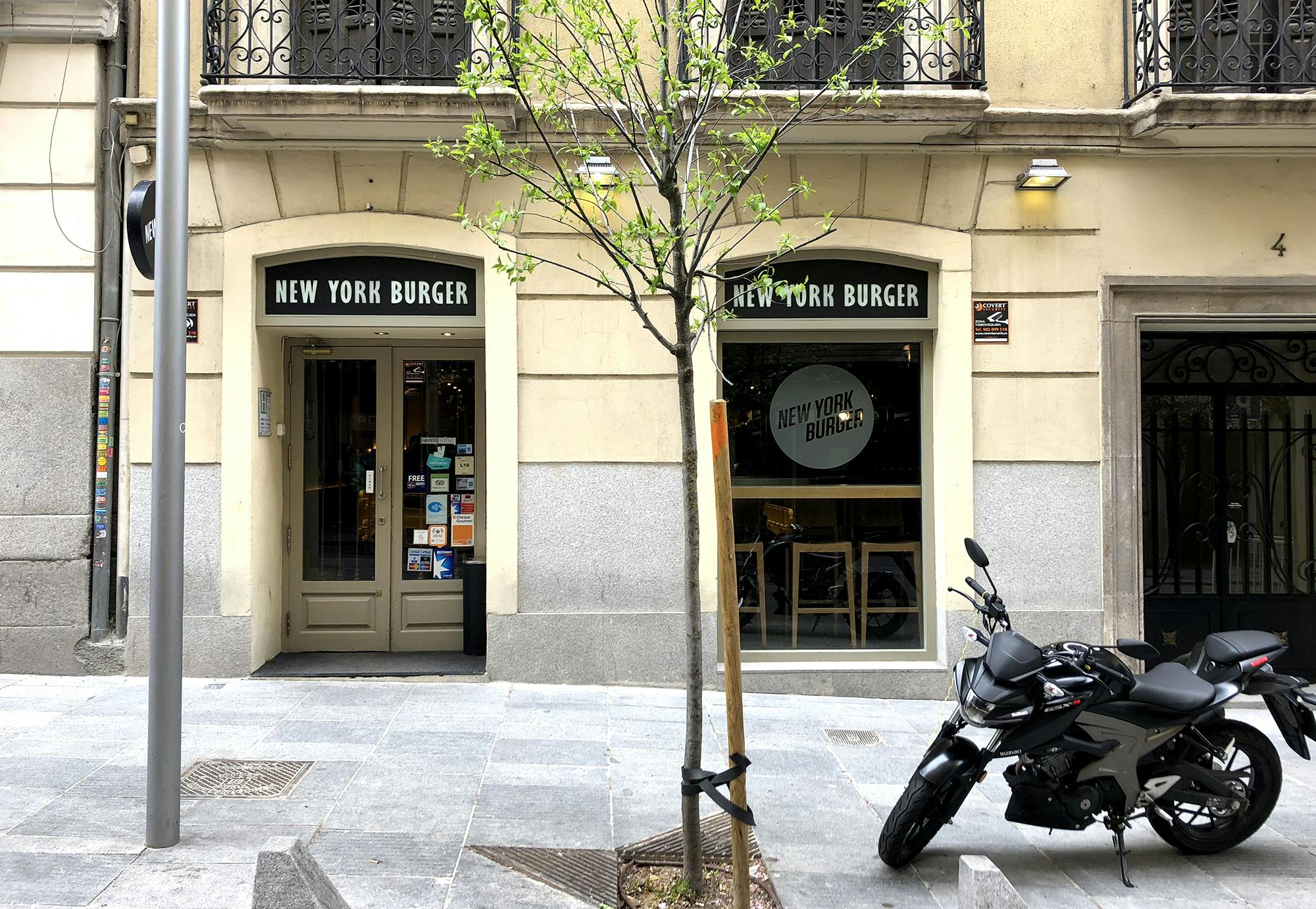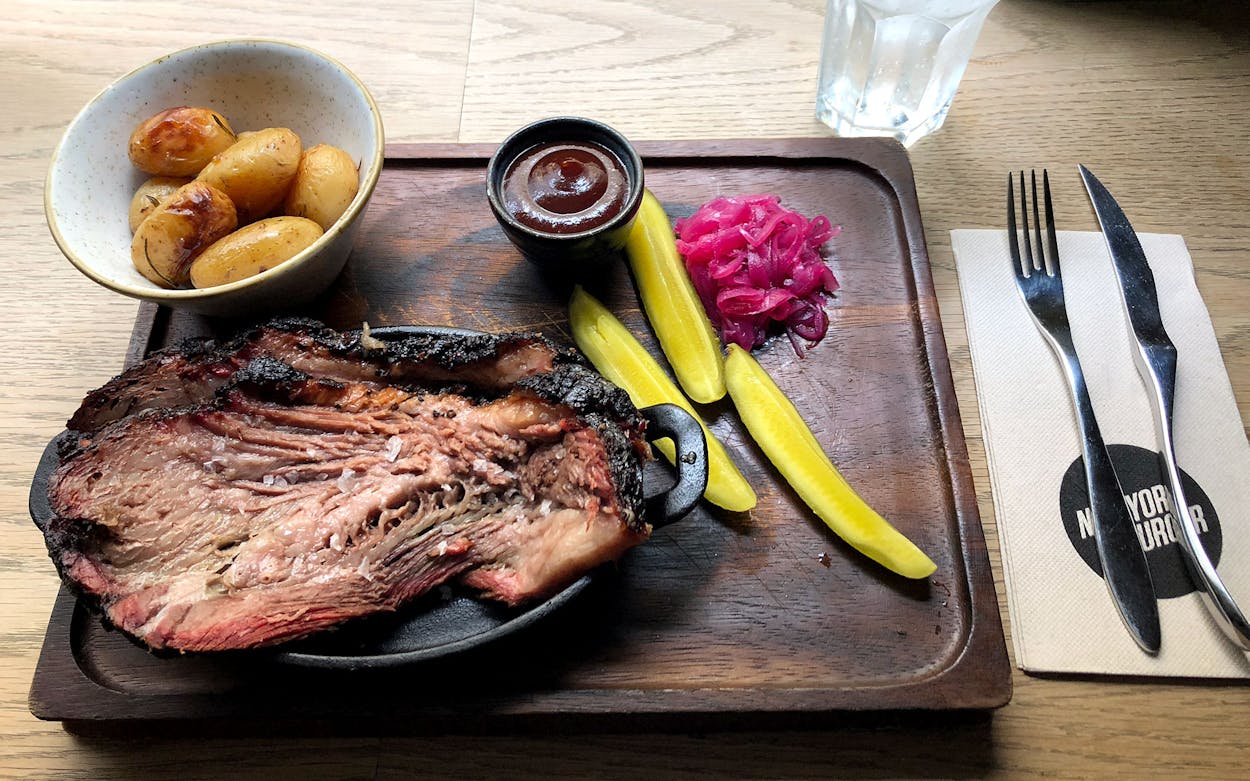“We would like to invite you to Madrid to try the BBQ line of products from New York Burger,” read the email from a Spanish public relations firm. I was suspicious. They spelled it “brisquet,” and it’s called New York Burger, but most importantly, why would a family-run restaurant in Spain be interested enough in my opinion of their barbecue to fly me to Madrid just to try it? I ignored them for months. Another message came in January of this year. I learned that the father-and-son team of Oscar and Pablo Colmenares had imported an Oyler smoker from Texas, and they were using Creekstone Farms briskets. They sounded serious about Texas barbecue and wanted my opinion.
I still waited a few more weeks to respond, and paused before hitting “send.” The email to New York Burger’s PR firm included my passport number. I’d never met or talked with any of the parties involved, but within hours they sent back the e-ticket for a round-trip flight to Madrid. They had assured me there was no expectation that I’d praise their barbecue. “There’s no guarantee I’ll write about it at all,” I told them. “Then again, I might tell the world it’s terrible,” I warned. No hay problema.
Pablo Colmenares was nervous as he approached the table. His excellent English was cracking, but his knife was steady. He is the brains behind the new barbecue program at the burger restaurant his father, Oscar, started nine years ago. A whole brisket, fresh from the kitchen, sat on a cutting board beside the table at New York Burger. It was an unusual situation for both of us: serving tableside is not the norm here, and this was far from how I typically try the first bite of brisket from a barbecue joint. Pablo was finding the perfect slice to serve me. “You’ve learned brisket slicing from the school of Aaron Franklin,” I joked. He nodded without dropping his determined look, and placed a few slices from the fatty end on my plate. I pointed to the thin, lean end of the brisket. “Give me a slice from here,” I told him. With a pained look, he obliged.
Almost anyone who has cooked a few briskets can serve up a good slice of fatty, but the test of a pitmaster is to provide lean brisket that is tender and moist. Pablo passed. This brisket had some issues. It was too salty, and overcooked (immensely preferable to undercooked) as well, but it had great flavor, good smoke, and was still juicy. It was also the best brisket I’ve had from a European barbecue joint. Pablo said he’d back off on the salt. The overcooking was a result of their smoking process, which differs quite a bit from barbecue joints in Texas, and also because Pablo is new to Texas barbecue. They’ve been serving it for less than a year.
Oscar Colmenares made a good living in the banking world, but as Pablo told me, “He realized it wasn’t the thing that was making him happy.” In 2009, he changed directions and opened New York Burger. The name might sound silly to Americans, but the Big Apple has a strong brand in Madrid, Pablo explained. For Madrileños, “if they haven’t ever been, they’re looking forward to go. If they have been, they feel a nostalgia about being there.” They serve the burgers on a familiar bun. I thought it was a Martin’s potato bun, like they use at Shake Shack, but they don’t ship to Spain. Oscar worked with a local bakery to mimic the flavor and texture (but not the yellow color). It’s a well-made burger. The restaurant was enough of a success that three more outposts opened, all of them situated along the spine of Madrid, “La Castellana,” the main boulevard through the city.

Pablo had finished business school and was entering law school when Oscar got into the restaurant business. Pablo was bored soon after and left school to move to London. He attended a year of Le Cordon Bleu, then returned to Madrid to take an internship with chef David Muñoz at DiverXO. By then, DiverXO had become one of only eight restaurants in Spain to receive its third Michelin star. Pablo began his work there by cleaning and cutting garnishes. When he left three years later, he had ascended to head chef. It was an incredible achievement, but the relentless seventeen-hour workdays were wearing on him. The only vacations he was afforded were spent in Texas beginning in 2015. He and his father went on a barbecue search, and came back to Spain with a new mountain to climb.
That first trip was to Houston, and it felt like a bust until the final day, when they stopped at Killen’s Barbecue in Pearland. “That was the eye-opener,” Pablo told me, with excitement in his voice as he relived that moment with his father. “We both took a bite at the same time, and we looked at each other,” he continued. “We didn’t have to talk. It was like ‘Oh yeah. This is it!’” A 2016 trip added Austin and Dallas to the itinerary. They raved about the food and hospitality at La Barbecue and about Franklin Barbecue‘s brisket. “My confirmation was at Franklin,” Pablo said, meaning that’s when he knew he wanted to make Texas barbecue his new passion. They visited the J&R Manufacturing factory in Mesquite during that same trip, and ordered the Oyler smoker soon after. Now they were committed.
A third trip to America last year began in New York. They stopped in Brooklyn for an impressive meal at Hometown Bar-B-Que in Brooklyn, then sampled some New York pastrami. New York Burger has just added a pastrami sandwich to its offerings (it’s not quite on the menu yet). They use deboned beef short ribs, which are brined for a week before getting a good dose of smoke. It makes for some incredibly moist pastrami, which they serve on grilled bread that holds up well to the generous portion of beef. It’s the one dish that adequately bridges the restaurant’s name with its new transformation into a barbecue destination.
There was some worry that the dining public in Madrid might not catch on to Texas barbecue. Texas wasn’t mythologized like New York, and barbecue in Madrid is about thin cuts that are quickly grilled. Their butchers don’t offer cuts that resemble brisket and beef ribs, and cuts like that would be braised anyway. There’s not even a word for brisket in Spanish, so both the Spanish and English menus use the same word. “We have to teach the people how to eat this thing,” Pablo said.
They’re off to a good start. It’s a challenge to recreate Texas barbecue when the smokers can’t be on site. The tight restaurant spaces in Madrid don’t allow for smokers in the restaurants, so they cook everything in a commissary kitchen off site. The meats smoke with Spanish oak wood, just sixty briskets per week for now between all four locations (with a fifth in development). The meats are smoked, then chilled quickly before being wrapped in Cryovac. The chilled meat is then sent to the restaurants, where it is slowly reheated in CVap ovens and served hot. Maybe a little too hot. I visited a second location, unsupervised, and the brisket came out in a small, preheated cast iron platter. The brisket was sliced a little wonky, but still had the great flavor of the brisket Pablo presented to me. It was during the reheat that the overcooking occurred, so we talked about backing off the doneness as the briskets come out of the smoker.
The rest of the barbecue menu is recognizable to any Texan, but the presentation might seem unfamiliar. The skin stays on the smoked turkey, and it’s crisped on the grill before serving. It also comes sitting in a cast iron skillet with a pool of gravy, just like you’d serve at Thanksgiving. It worked, and was far better than the meat being covered in their sweet sauce. That sauce is far too prominent in the pulled pork, where the flavor of the protein is not discernible. That same pulled pork is oddly plopped into a skillet of melted cheese for the restaurant’s tacos. The corn tortillas served alongside are fine, as are the pickled jalapeños, but the guacamole, soured by a citric acid preservative, made me weep for the people of Madrid, who rarely get fresh avocados.
Sausage doesn’t get a spot at the Spanish barbecue table. Pablo shrugged when I mentioned it, and said, “People here don’t eat much sausage.” Charcuterie like jamón, chorizo, and morcilla get all the love. Spaniards also like very tender pork ribs. Pablo keeps the membrane on the baby back ribs because they’d disintegrate otherwise. The Spanish pork has much more meat on the bones than what we serve in Texas, so I can understand the desire to cook it longer. They were luxuriously fatty, with a nice char from a finish on the wood-fired grill before serving. Still, I like a rib with a little more chew.
Pablo and Oscar have come a long way in just a year. Pablo thought back to the first briskets that came off their new Oyler smoker. “It was awful,” he said, laughing. They used Spanish beef, which didn’t perform well. “It was so over-smoked with lots of dirty smoke,” he added. They’ve had to learn the ins and outs of the pit while also trying to persuade the people of Madrid to try this new cuisine. “They didn’t know they loved it because they’d never had real barbecue,” Pablo said. Now he’s changing minds about barbecue and Texas cuisine in Madrid. He says even his old chef and master of the tasting menu, David Muñoz, is a fan. But it’s the repeat customers that are the most satisfying. Pablo says they ask him, or maybe they’re asking the Texas barbecue, “Where you were all my life?”








